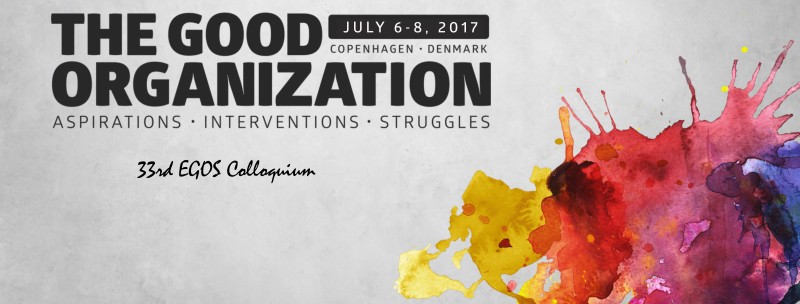Sub-theme 36: Using Design in, around and for Good Organizations
Call for Papers
Design principles and practices are becoming increasingly relevant for organizations. Initially applied to industrial products
and graphics, they are now touted as possible solutions to a broader range of problems that include organizational design,
social issues, and policy intervention (Brown & Martin, 2015). Deeply rooted in the Scandinavian and, more generally,
European tradition, design principles and practices might hold the key to unlock the benefits of the “good organization” by
negotiating the struggles associated to different aspirations of goodness coming from its stakeholders.
Research
has shown that using design to innovate might lead to “good organizations” that are both better performing (Gruber et al.,
2015) and more responsive to human needs (Brown, 2008), both of customers and of employees (Gruber et al., 2015). More specifically,
using design principles and processes in managing organizations might reframe stakeholders’ competing ambitions and interests
from incompatible to interdependent, thus turning a dualism into a duality (Farjoun, 2010), similarly to what design does
when simultaneously addressing – and balancing – form and function.
Scholars have argued that a design approach
to address organizational problems is needed for moving beyond a purely structural recipe towards a more human and creative
view of organizations (Gruber et al., 2015; Boland & Collopy, 2004). Yet, while human-centered approaches to innovation
and change are now taught at design schools and business schools all over the world – in the form of “design thinking” (Dunne
& Martin, 2006; Brown, 2008) – we still know relatively little about the cognitive processes and social practices that
underlie such approach to the design of new product and services, and its transferability to broader social and organizational
issues.
Most management literature has portrayed design quite narrowly, as “something that happens to products;
or […] some kind of uber-planning and analysis” (Liedtka & Mintzberg, 2006: 10). However, such a simplified view does
not do justice to the nature of design principles and practices and their relevance for management. Aside from a few insights
into what design is and the potential it holds for organizations (cf. Liedtka, 2015; Porac & Tschang, 2013), there are
still vast areas of design theory and practice left unexplored in the organizational literature, especially via empirical
studies (for exceptions, cf. Hargadon & Sutton, 1997; Stigliani & Ravasi, 2012).
This sub-theme will
provide an opportunity for organizational scholars interested in how design is used in, around, and for organizations to deepen
our understanding of this phenomenon as well as to provide a clear(er) research agenda for this topic. To this end, we invite
theoretical and empirical papers that further our understanding of design in organizations. Examples of particularly relevant
questions are, among others:
- How can design principles and practices be transferred effectively from their original domain of application and applied to a broader set of organizational, social, or policy issues? What enables them to address these issues effectively and creatively?
- Can design practices be taught to managers and, if so, how? How can intensive pedagogical experiences compensate years of professional training and practice?
- Can managers really learn to think like designers in their everyday work? What are the cognitive and institutional obstacles for this to happen? On the other hand, what enables such learning?
- To what extent the presence of a trained designer is always needed to enact design-based solutions in organizations?
- When is a design approach to management most effective, and for what purpose? Can the use of design to address traditional managerial issues become counterproductive?
- “What are design capabilities really, and where do they come from?” (Ravasi & Stigliani, 2012, p. 476)?
- How can organizations learn to routinely and effectively employ design to support their activities?
- How can design principles be legitimated when applied to traditional organizations? How can we overcome barriers to their effective implementation in such contexts?
- How can we measure the impact of design in organizations?
Works focusing on other aspects of design in organizations
will also be considered. Due to the scarcity – and relevance – of empirical studies of design, we plan to prioritize empirically
grounded studies, using either qualitative, quantitative, or mixed methods. Particularly, strong theoretical works will also
be favorably considered.
References
- Boland, R., & Collopy, F. (2004): Managing as Designing. Stanford, CA: Stanford Business Books.
- Brown, T. (2008): “Design thinking.” Harvard Business Review, June, 84–92.
- Brown, T., & Martin, R. (2015): “Design for action.” Harvard Business Review, September, 56–64.
- Dunne, D., & Martin, R. (2006): “Design thinking and how it will change management education: An interview and discussion.” Academy of Management Learning & Education, 5, 512–523.
- Farjoun, M. (2010): “Beyond dualism: Stability and change as a duality.” Academy of Management Review, 35, 202–225.
- Gruber, M., de Leon, N., George, G., & Thompson, P. (2015): “Managing by design.” Academy of Management Journal, 58, 1–7.
- Hargadon, A.B., & Sutton, R.I. (1997): “Technology brokering and innovation in a product development firm.” Administrative Science Quarterly, 42, 716.
- Liedtka, J. (2015): “Perspective: Linking design thinking with innovation outcomes through cognitive bias reduction.” Journal of Product Innovation Management, 32, 925–938.
- Liedtka, J., & Mintzberg, H. (2006): “Time for design.” Design Management Review, 17, 10–18.
- Porac, J., & Tschang, F.T. (2013): “Unbounding the managerial mind: It’s time to abandon the image of managers as ‘small brains’.” Journal of Management Inquiry, 22, 250–254.
- Ravasi, D., & Stigliani, I. (2012): “Product design: A review and research agenda for management studies.” International Journal of Management Reviews, 14, 464–488.
- Stigliani, I., & Ravasi, D. (2012): “Organizing thoughts and connecting brains: Material practices and the transition from individual to group-level prospective sensemaking.” Academy of Management Journal, 55, 1232–1259.


